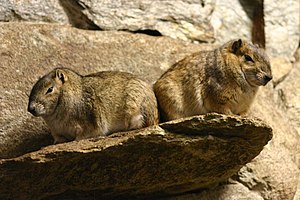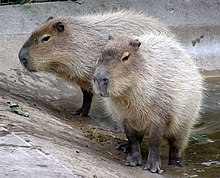Kerodon
| Kerodon | ||||||||||||
|---|---|---|---|---|---|---|---|---|---|---|---|---|

Mountain Guinea Pig ( Kerodon rupestris ) |
||||||||||||
| Systematics | ||||||||||||
|
||||||||||||
| Scientific name | ||||||||||||
| Kerodon | ||||||||||||
| F. Cuvier , 1823 |
Kerodon is agenus of rodents in the guinea pig family(Caviidae). It consists of two species, the mountain guinea pig ( Kerodon rupestris ) and the climbing guinea pig ( Kerodon acrobata ). The species live in dry and rocky habitats in northeastern Brazil .
features
The species of the genus Kerodon are rodents of moderate size. They reach body sizes of around 30 to 40 centimeters and weigh around one kilogram, whereby the mountain guinea pig remains significantly smaller and lighter than the climbing guinea pig. This means that they correspond in size and general appearance to other guinea pig species and are significantly smaller than the closely related capybaras . The color of the back of the animals is gray- agouti , the color of the abdomen is somewhat lighter. In both species the tail is clearly receded or absent. Like other relatives of guinea pigs, the animals have four toes on their front feet and only three toes on their hind feet , however , Kerodon species have no claws and the toes are instead covered with a thick leather-like cuticle . The only exception is the innermost toe, which has a single cleaning claw .
The skull and especially the snout region is very narrow and long, significantly narrower than that of other guinea pigs. The diastema between the incisor teeth and the premolars is also proportionally much longer. The incisor window is significantly narrowed. The infraorbital window has no nerve canal. The sternum is narrow and rounded instead of wide and flat like other guinea pigs.
Distribution area and habitat
The species of the genus Kerodon occur in two separate distribution areas in northeastern Brazil. The mountain guinea pig lives in the extreme northeast of the state from the southwest of Minas Gerais to the northeast of Ceará . The significantly smaller area of distribution of the climbing guinea pig is somewhat more central in the border area between Goiás and the neighboring Tocantins .
Both species are habitat specialists that colonize the rocky regions of the semi-arid Caatinga region.
Systematics
|
Phylogenetic systematics of guinea pigs (Caviidae)
|

The genus Kerodon was first scientifically described by Frédéric Cuvier in 1823 , whereby the mountain guinea pig described by Maximilian zu Wied-Neuwied in 1820 formed the nomenclatory type . The description appeared in his work Des dents des mammifères considérés comme caractère zoologique , whose rodent volume appeared in 1823. The first valid scientific description of the climbing guinea pig within the genus was made in 1997 by Moojen, Locks and Langguth, after the species was first named in 1982, but not scientifically described and the scientific name was thus treated as a nomen nudum .
The genus Kerodon was originally closely related to the real guinea pigs , but genetic studies have shown that the mountain guinea pigs are more closely related to the capybara ( Hydrochoerus hydrochaeris ), making them a monophyletic group. More recent classifications such as Wilson & Reeder (2005) include Kerodon and the Capybaras in the subfamily of Hydrochoerinae within the guinea pigs (Caviidae). Whether the actual guinea pigs or the pampas rabbits (Dolichotinae) are to be considered as sister group of the Hydrochoerinae has not yet been conclusively clarified and varies with the various authors.
Within the rodents they belong to the superfamily of the guinea pig-like (Cavioidea), to which the Agutis and Acouchis (Dasyproctidae), the Pakas (Cuniculidae) and the Pakarana (Dinomyidae) belong.
Fossil history
The genus has been fossilized since the Pleistocene .
supporting documents
- ↑ a b c d e James L. Patton: Genus Kerodon F. Cuvier, 1823 In: James L. Patton, Ulyses FJ Pardinas, Guillermo D'Elía (eds.): Mammals of South America, Volume 2 - Rodents. The University of Chicago Press, Chicago 2015; Pp. 724-725. ISBN 978-0-226-16957-6 .
- ↑ James L. Patton: Kerodon repustris (Wied-Neuwied, 1820) In: James L. Patton, Ulyses FJ Pardinas, Guillermo D'Elía (eds.): Mammals of South America, Volume 2 - Rodents. The University of Chicago Press, Chicago 2015; 726. ISBN 978-0-226-16957-6 .
- ↑ a b James L. Patton: Kerodon acrobata Moojen, Locks, and Langguth, 1992 In: James L. Patton, Ulyses FJ Pardinas, Guillermo D'Elía (Eds.): Mammals of South America, Volume 2 - Rodents. The University of Chicago Press, Chicago 2015; P. 725. ISBN 978-0-226-16957-6 .
- ^ A b Diane L. Rowe, Rodney L. Honeycutt: Phylogenetic Relationships, Ecological Correlates, and Molecular Evolution Within the Cavioidea (Mammalia, Rodentia). Molecular Biology and Evolution 19 (3), 2002; Pp. 263-277. ( Full text )
- ↑ a b c Hydrochoeris ( Memento of the original from January 3, 2016 in the Internet Archive ) Info: The archive link was inserted automatically and has not yet been checked. Please check the original and archive link according to the instructions and then remove this notice. . In: Don E. Wilson , DeeAnn M. Reeder (Eds.): Mammal Species of the World. A taxonomic and geographic Reference. 2 volumes. 3. Edition. Johns Hopkins University Press, Baltimore MD 2005, ISBN 0-8018-8221-4 .
- ↑ James L. Patton: Subfamily Hydrochoerinae Gray, 1825 In: James L. Patton, Ulyses FJ Pardinas, Guillermo D'Elía (Eds.): Mammals of South America, Volume 2 - Rodents. The University of Chicago Press, Chicago 2015; P. 720. ISBN 978-0-226-16957-6 .
literature
- James L. Patton: Genus Kerodon F. Cuvier, 1823 In: James L. Patton, Ulyses FJ Pardinas, Guillermo D'Elía (Eds.): Mammals of South America, Volume 2 - Rodents. The University of Chicago Press, Chicago 2015; Pp. 724-725. ISBN 978-0-226-16957-6 .